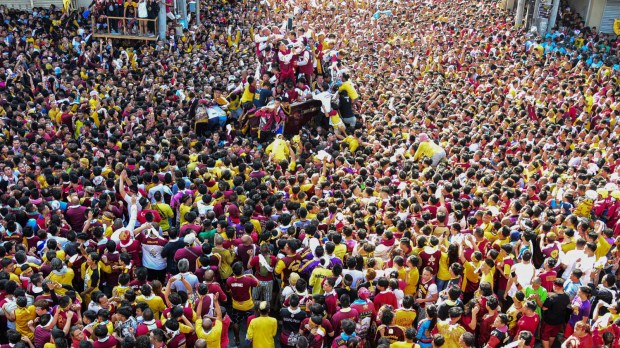More than 6 million Filipino Catholic devotees flooded the streets of Manila on Tuesday, January 9, 2024, for the annual Procession of the Black Nazarene, marking the triumphant return of the centuries-old tradition after a three-year hiatus due to the COVID-19 pandemic.
The iconic dark wooden statue of Jesus Christ, revered as a statue with which God grants his healing powers, drew massive crowds that turned the city into a sea of maroon and yellow – the colors associated with the Nazarene.
According to Reuters, early police estimates put the initial turnout at more than 830,000 people, which later swelled to a staggering 6.5 million by the time the procession reached its destination at Quiapo Church, the statue’s home.
Devotees, many barefoot, crowded the 6-kilometer route, eager to touch or simply be near the revered statue. Some sought intercession for personal troubles, while others expressed pure joy and gratitude for the return of the beloved tradition.
Thousands of police officers were deployed to keep order as the fervent crowd surged toward the statue’s carriage, which depicts Jesus bearing the cross.
“The atmosphere was electric,” said Father Gerard Francisco, a priest at the Quiapo church. “People were crying, praying, singing hymns — it was an overwhelming demonstration of faith and resilience after the challenges we’ve faced,” Reuters reported.
The origin of the statue’s dark hue remains a mystery. Carved in Mexico and brought to the Philippines in the early 17th century, its color has sparked various theories, with one suggestion attributing it to the natural properties of the mesquite wood from which it was made.
The procession of the Black Nazarene is more than a religious spectacle. It is a powerful symbol of the Filipino spirit, demonstrating the nation’s ability to find hope and unity in the midst of adversity. After enduring the hardships of the pandemic, the event became a beacon of faith and shared belief, bringing millions together in a collective outpouring of devotion.
The procession of the Black Nazarene, with its historic roots, fervent crowds, and enduring significance, is a testament to the Philippines’ deep-seated faith and the indomitable spirit of its people.


